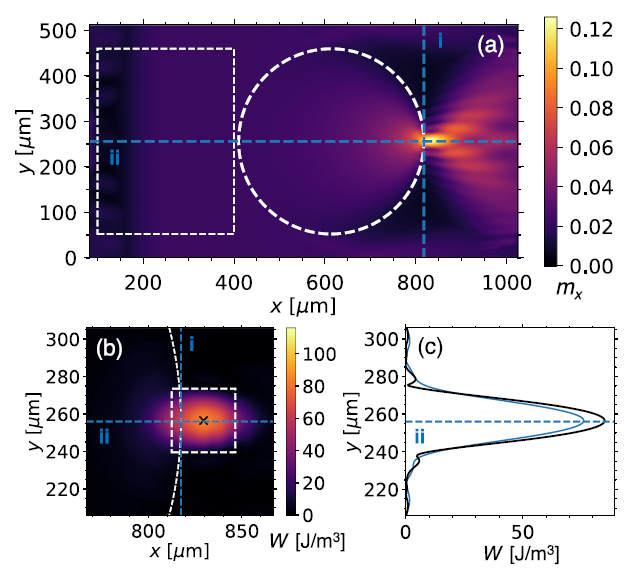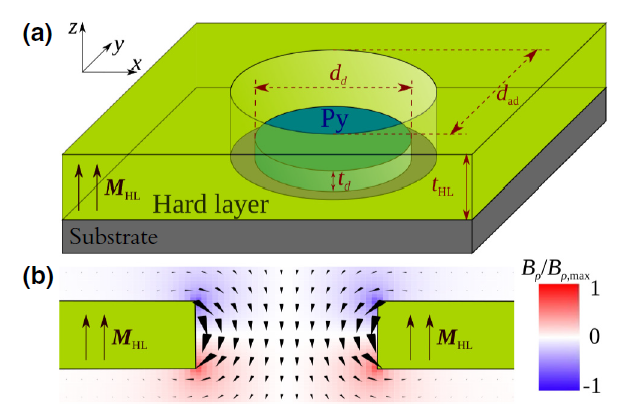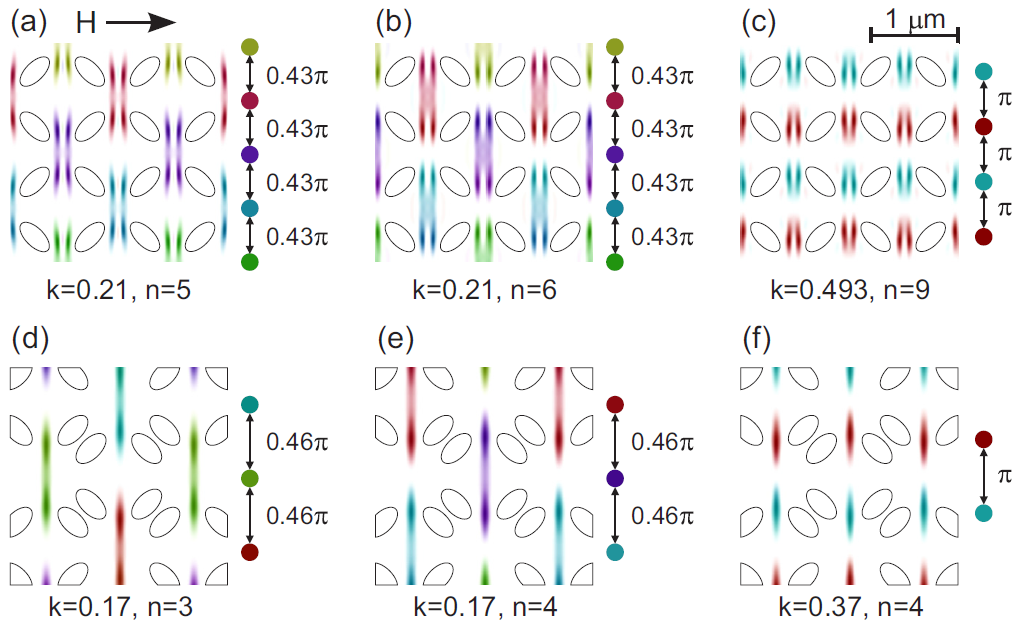N.J. Whitehead, S.A.R. Horsley, T.G. Philbin, and V.V. Kruglyak
Appl. Phys. Lett. 113, 212404 (2018)
We report on the theory of a Luneburg lens for forward-volume magnetostatic spin waves and verify its operation via micromagnetic modelling. The lens converts a plane wave to a point source, and vice versa, by a designed graded refractive index, realized by modulating either the thickness or the saturation magnetization in a circular region. We find that the lens enhances the wave amplitude by about 5 times at the lens focus, and 47% of the incident energy arrives in the focal region. A lens with small deviations from the optimal profile can still result in good focusing if the index is graded smoothly.

Fig.1. (a) Maximum amplitude of mx attained across the model over the duration of the simulation. The rectangular box indicates the region used to calculate the incident spin wave energy. (b) Energy density, W, near the focus region at the time of peak amplitude. The white square has a side of k and is centered on peak of the actual focus spot (black cross). (c) Energy density cross-sections for the line i from panels (a) and (b) (blue line) and at the x position of the actual focus (black line), at the times when the maximum amplitude occurs.
O. V. Dobrovolskiy, R. Sachser, T. Brächer, T. Böttcher, V. V. Kruglyak, R. V. Vovk, V. A. Shklovskij, M. Huth, B. Hillebrands, and A. V. Chumak
Nature Physics (2019)
Ferromagnetism and superconductivity are most fundamental phenomena in condensed-matter physics. Entailing opposite spin orders, they share an important conceptual similarity: disturbances in magnetic ordering in magnetic materials can propagate in the form of spin waves (magnons) while magnetic fields penetrate superconductors as a lattice of magnetic flux quanta (fluxons). Despite a rich choice of wave and quantum phenomena predicted, magnon–fluxon coupling has not been observed experimentally so far. Here, we clearly evidence the interaction of spin waves with a flux lattice in ferromagnet/superconductor Py/Nb bilayers. We demonstrate that, in this system, the magnon frequency spectrum exhibits a Bloch-like band structure that can be tuned by the biasing magnetic field. Furthermore, we observe Doppler shifts in the frequency spectra of spin waves scattered on a flux lattice moving under the action of a transport current in the superconductor.

Fig.1. (a,b), Sketch (a) and false-colour scanning electron micrograph (b) of the Nb and Au layout. The Py/Nb bilayer is in an inclined magnetic field μ0Hext with a constant in-plane component μ0H|| = 59.5 mT and an out-of-plane component μ0H⊥ varying between 3 and 11 mT. BVMSWs are excited by antenna 1, propagate through the Py waveguide, whose arrangement is indicated by the dashed lines in b, and are detected by antenna 2. The vortex lattice induces a spatially periodic magnetic field h(x, y) in Py, which becomes alternating in time when the vortices move.
R.V. Verba, D. Navas, A. Hierro-Rodriguez, S.A. Bunyaev, B.A. Ivanov, K.Y. Guslienko, G.N. Kakazei
Phys. Rev. Applied 10, 031002 (2018)
Static magnetic configurations of thin, circular, soft (permalloy) magnetic nanodots, coupled to a hard antidot matrix with perpendicular magnetization, are studied by micromagnetic simulations. It is demonstrated that dipolar fields of the antidot matrix promote the formation of a magnetic-vortex state in nanodots. The vortex is the dot ground state at zero external field in ultrathin nanodots with diameters as low as 60 nm, which is far beyond the vortex stability range in an isolated permalloy nanodot. Depending on the geometry and antidot-matrix material, it is possible to stabilize either a radial vortex state or unconventional vortices with the angle between in-plane magnetization and radial direction ψ≠0,π/2.

Fig.1. (a) A sketch of the considered nanostructure—a soft magnetic nanodot placed within an antidot in a hard magnetic layer with perpendicular magnetization. (b) Distribution of stray fields in the antidot; arrow length corresponds to the field magnitude and color to the field radial component Bρ.
S. Mamica, X. Zhou, A. Adeyeye, M. Krawczyk and G. Gubbiotti
Phys. Rev. B 98, 054405 (2018)
Reversed structures of artificial spin-ice systems, where elongated holes with elliptical shape (antidots) are arranged into a square arraywith two orthogonal sublattices, are referred to as antisquared spin ice. Using Brillouin light-scattering spectroscopy and plane-wave-method calculations, we investigate the spin-wave propagation perpendicular to the applied field direction for two 20-nm-thick Permalloy nanostructures which differ by the presence of single- and double-elliptical antidots. For the spin-wave propagation along the principal antidot lattice axis, the spectrum consists of flat bands separated by several frequency gaps which are the effect of spin-wave amplitude confinement in the regions between antidots. Contrarily, for propagation direction at 45° with respect to the antidot symmetry axis, straight and narrow channels of propagation are formed, leading to broadening of bands and closing of the magnonics gaps. Interestingly, in this case, extra magnonic band gaps occur due to the additional periodicity along this direction. The width and the position of these gaps depend on the presence of single or double antidots. In this context, we discuss possibilities for the tuning of spin-wave spectra in antisquared spin-ice structures.

Fig.1. SW profiles of the modes bounding the lowest magnonic band gaps for φ = 45◦ in (a)–(c) ASSI and (d)–(f) ACSSI structures. The bounds of the gaps are marked with red spots. Colors represent argument (phase of SW) and their intensity modulus of the dynamic magnetization, as it is shown in the inset. The change of the phase along the vertical direction within each profile is also provided on the right side of each plot. Below each profile its wave vector k (in 107 rad/m) and the mode number in the frequency spectrum n are specified.

